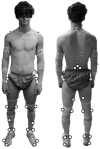Can coordination variability identify performance factors and skill level in competitive sport? The case of race walking
- PMID: 30356959
- PMCID: PMC6191987
- DOI: 10.1016/j.jshs.2015.11.005
Can coordination variability identify performance factors and skill level in competitive sport? The case of race walking
Abstract
Background: Marginal changes in the execution of competitive sports movements can represent a significant change for performance success. However, such differences may emerge only at certain execution intensities and are not easily detectable through conventional biomechanical techniques. This study aimed to investigate if and how competition standard and progression speed affect race walking kinematics from both a conventional and a coordination variability perspective.
Methods: Fifteen experienced athletes divided into three groups (elite, international, and national) were studied while race walking on a treadmill at two different speeds (12.0 and 15.5 km/h). Basic gait parameters, the angular displacement of the pelvis and lower limbs, and the variability in continuous relative phase between six different joint couplings were analyzed.
Results: Most of the spatio-temporal, kinematic, and coordination variability measures proved sensitive to the change in speed. Conversely, non-linear dynamics measures highlighted differences between athletes of different competition standard when conventional analytical tools were not able to discriminate between different skill levels. Continuous relative phase variability was higher for national level athletes than international and elite in two couplings (pelvis obliquity-hip flex/extension and pelvis rotation-ankle dorsi/plantarflexion) and gait phases (early stance for the first coupling, propulsive phase for the second) that are deemed fundamental for correct technique and performance.
Conclusion: Measures of coordination variability showed to be a more sensitive tool for the fine detection of skill-dependent factors in competitive race walking, and showed good potential for being integrated in the assessment and monitoring of sports motor abilities.
Keywords: Biomechanics; Gait; Joint coupling; Motor control; Sports technique; Training.
Figures





Similar articles
-
Effects of motor skill level and speed on movement variability during running.J Biomech. 2021 Oct 11;127:110680. doi: 10.1016/j.jbiomech.2021.110680. Epub 2021 Aug 10. J Biomech. 2021. PMID: 34418864
-
Segment coupling and coordination variability analyses of the roundhouse kick in taekwondo relative to the initial stance position.J Sports Sci. 2016 Sep;34(18):1766-73. doi: 10.1080/02640414.2015.1137342. Epub 2016 Jan 25. J Sports Sci. 2016. PMID: 26805571
-
Contributions to the understanding of gait control.Dan Med J. 2014 Apr;61(4):B4823. Dan Med J. 2014. PMID: 24814597 Review.
-
Is coordination variability using vector coding different in overground and treadmill walking and running?Gait Posture. 2022 Feb;92:413-420. doi: 10.1016/j.gaitpost.2021.12.016. Epub 2021 Dec 22. Gait Posture. 2022. PMID: 34968998
-
The biomechanics of race walking: literature overview and new insights.Eur J Sport Sci. 2014;14(7):661-70. doi: 10.1080/17461391.2013.878755. Epub 2014 Jan 17. Eur J Sport Sci. 2014. PMID: 24438531 Review.
Cited by
-
Non-linearity in the dynamic world of human movement.J Sport Health Sci. 2016 Mar;5(1):1-2. doi: 10.1016/j.jshs.2016.01.001. Epub 2016 Jan 6. J Sport Health Sci. 2016. PMID: 30356870 Free PMC article. No abstract available.
-
Channel catfish use higher coordination to capture prey than to swallow.Proc Biol Sci. 2019 Apr 24;286(1901):20190507. doi: 10.1098/rspb.2019.0507. Proc Biol Sci. 2019. PMID: 30991933 Free PMC article.
-
The Role of Upper Body Biomechanics in Elite Racewalkers.Front Sports Act Living. 2021 Jul 9;3:702743. doi: 10.3389/fspor.2021.702743. eCollection 2021. Front Sports Act Living. 2021. PMID: 34308349 Free PMC article.
-
Differences in Coordination Motor Abilities between Orienteers and Athletics Runners.Int J Environ Res Public Health. 2023 Feb 1;20(3):2643. doi: 10.3390/ijerph20032643. Int J Environ Res Public Health. 2023. PMID: 36768012 Free PMC article.
-
Segment Coordination Variability Differs by Years of Running Experience.Med Sci Sports Exerc. 2019 Jul;51(7):1438-1443. doi: 10.1249/MSS.0000000000001913. Med Sci Sports Exerc. 2019. PMID: 30688768 Free PMC article.
References
-
- International Association of Athletics Federations (IAAF) 2014. Competition Rules 2014–2015. Monaco.
-
- Pavei G., Cazzola D., La Torre A., Minetti A.E. The biomechanics of race walking: literature overview and new insights. Eur J Sport Sci. 2014;14:661–670. - PubMed
-
- Dona G., Preatoni E., Cobelli C., Rodano R., Harrison A.J. Application of functional principal component analysis in race walking: an emerging methodology. Sports Biomech. 2009;8:284–301. - PubMed
-
- Hanley B., Bissas A., Drake A. Kinematic characteristics of elite men's and women's 20 km race walking and their variation during the race. Sports Biomech. 2011;10:110–124. - PubMed
-
- Hanley B., Bissas A., Drake A. Kinematic characteristics of elite men's 50 km race walking. Eur J Sport Sci. 2013;13:272–279. - PubMed
LinkOut - more resources
Full Text Sources

